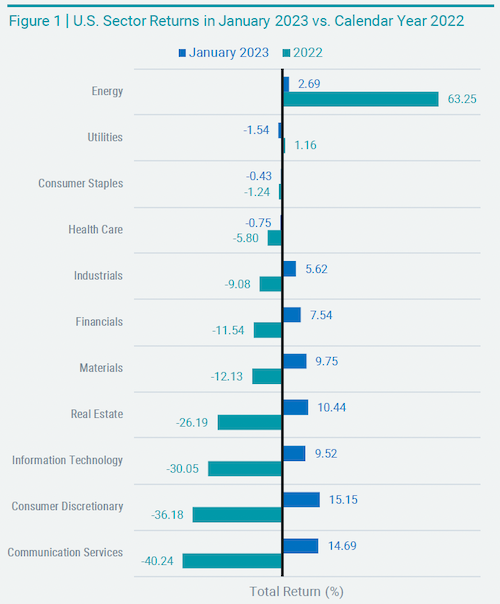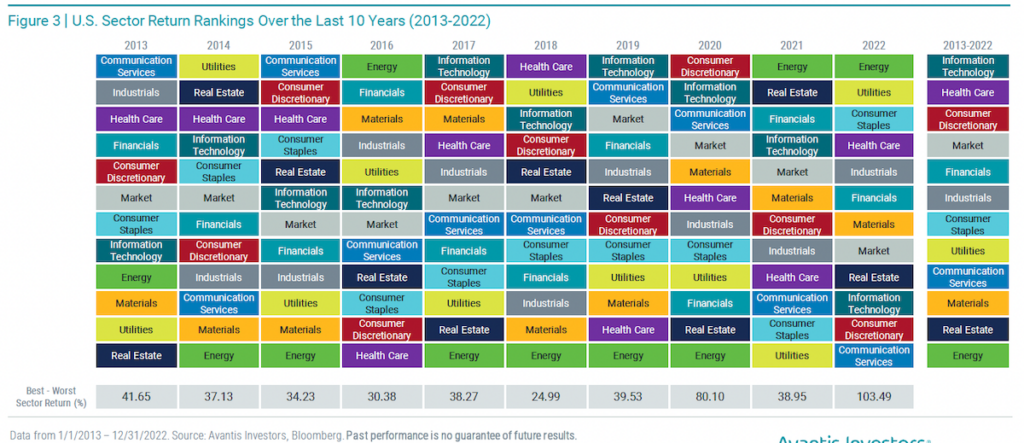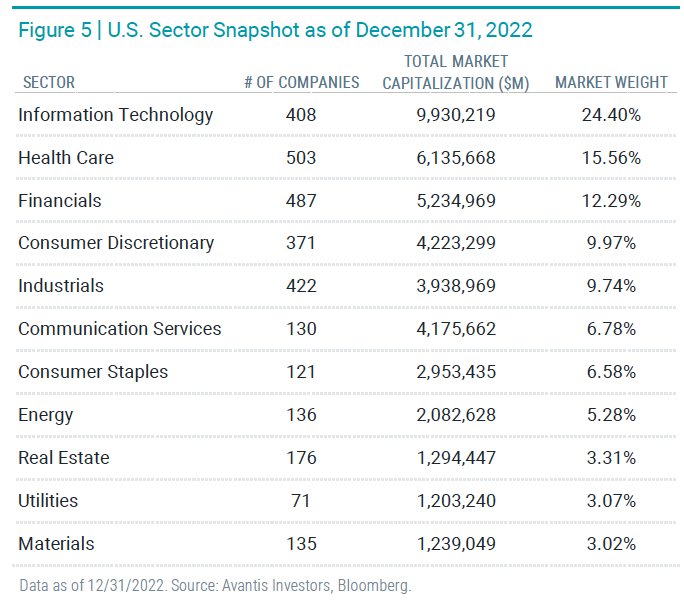So far in 2023, the performance of the broad U.S. stock market has looked pleasantly different than what investors faced over the course of 2022. In January, the Russell 3000® Index returned nearly 7%, compared to a nearly 20% loss last year.
If we dig a little deeper to deconstruct the index into its sector components, we find that the sectors leading the charge this year are also quite different than the best performers in 2022. See Figure 1.

Last year, energy far and away led the pack as one of only two sectors with positive returns by delivering more than 60% for the year. In 2023, however, energy is near the bottom of the stack and below the total market return. Conversely, the two worst-performing sectors of 2022 — consumer services and consumer discretionary — were the best-performing sectors in January.
Some may view this as the start of a new cycle where good times have begun for sectors that previously faced headwinds. History gives us reason to believe caution is warranted.
In Figure 2, we show how sectors performed during each month of 2022, ranked from best to worst. Both the magnitude of return differences between sectors each month and the variability in sector returns from month to month may surprise some investors. For example, the average difference in returns between the top- and bottom-performing sectors was more than 15%, and the largest month-to-month difference for an individual sector was energy, with a whopping swing of about 32% (up over 15% in May but then retreating by 17% in June).

We can glean additional insights using the high-flying energy sector. While energy stocks offered the highest return in six out of 12 months, the sector’s June return of -17% was the worst single-month return of all sectors throughout the year.
If an investor saw the outsized returns in energy from January through May and chose to invest in all companies in the sector at the start of June, she would have earned less than 4% over the final seven months of the year. This compares to the more than 63% return the energy sector delivered over the entire year.
While the nearly 4% return to energy stocks was still the best return of all sectors over those final seven months of the year, that would have required the investor to stay invested through a highly volatile period. After four months of holding energy stocks, she would have been down more than 14% while lagging six other sectors.
This example shines a light on the fact that when concentrating in a single sector with the goal of beating the market, you have to first pick correctly and then also have the conviction to stick with it through the ups and downs.
Figure 3 offers a longer-term perspective, presenting annual sector performance ranked from best to worst over the last 10 calendar years and for the full 10-year period. Again, the variability in sector returns is clear. Over these 10 years, six of 12 sectors were the highest performing sector at least once, with a sector repeating as the leader in consecutive years only once. Five were the worst-performing sector in at least one year over the period.

The difference between the best- and worst-performing sectors each year further highlights the risk of attempting to pick a specific sector that could outperform. While this strategy could generate big profits if you chose the right one, it could also lead to disastrous results if you were wrong. Consider that communication services stocks in 2022 underperformed energy stocks by more than 100% and the total market index by more than 20%.
The market return, shown in light grey, always falls somewhere in the middle compared to its constituent sectors, never the highest return but, importantly, never the worst return. And, over this 10-year period, the market delivered an annualized return of more than 12% with positive returns in eight of 10 years.
The full-period return rankings show that information technology had a good run, besting the market, while energy lagged. However, energy topped the charts in the prior decade, with information technology middle of the pack. Past sector performance, whether over a month, year, or decade offers little information to predict which sectors should do well tomorrow.
Further, we observe wide dispersion in returns from the individual companies that make up each sector. As an example, consider the materials sector in 2022, as depicted in Figure 4. We ranked each of the sector’s constituent stocks by its 2022 return, examining the high and low-return stocks based on the 75th and 25th percentile rankings.

While materials stocks returned -12.13% overall, we observed a big difference between “high return stocks” at 8.46% and “low return stocks” at -25.85%. Examining the characteristics of materials companies above the high return percentile rank and those below the low return percentile rank, we find the high-return stocks to have meaningfully higher book-to-market ratios (lower prices relative to book values) and higher profitability.
This simple example highlights that the sector itself doesn’t drive returns, and not all stocks in a sector have the same expected return. Company valuations matter.
Fortunately, investors don’t have to play the sector guessing game. Embracing broad diversification means that not every sector has to increase in value for your portfolio to earn a positive return in any single year and over the long term.
While Figures 1-4 spotlight the challenge of predicting which sectors will outperform, Figure 5 highlights the broad exposure that investors may give up by concentrating weight in, or heavily overweighting, a single sector.

Energy offers another good example. If an investor were to allocate his portfolio to just the energy sector, he would be missing out on almost 95% of the investible U.S. stock market. Even allocating to just the largest sector – information technology – would leave out three-quarters of the investible universe.
The principles of diversifying investments across sectors are similar to those of diversifying investments across asset classes and geographies. Allocating your investments in a manner that offers both a wide opportunity set to participate in capital markets and aligns with your investment goals and horizon may increase your odds of success if you stick to your plan over the long term.
While it may be tempting to chase that top-performing sector or only hold what we perceive as “safe” investments during periods of volatility, we shouldn’t forget that the market is simply the sum of each sector and the companies that make it up — all with the opportunity to be that next top performer.
We believe an important benefit to investors who buy and hold diversified portfolios is knowing they’ll own the winners over any period. Over the long term, these investors have typically been rewarded.
Download a PDF of this article
Download the February 2023 Market Review
This article was provided by Avantis Investors and we have been given permission to share this information with our clients and potential clients.







